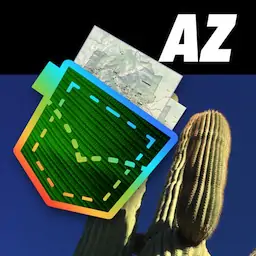"B02 North Porch of Hubbell Home" by U.S. National Park Service , public domain
The Navajo Long Walk - HweeldiHubbell Trading Post |
featured in
| National Parks Pocket Maps |  | |
| Arizona Pocket Maps |  |
Hubbell Trading Post
National Park Service
U.S. Department of the Interior
Hubbell Trading Post
National Historic Site
The Long Walk–Hwéeldi
For centuries before the coming of European settlers, The Navajo (Diné-The People) were accustomed to roaming freely over the vast distances of the great Southwest. This is the land that their
Holy People had created for them, “Dinétah,” the land within their Four Sacred Mountains. Life
was hard, but good. They traded with neighboring Pueblo tribes, which enriched them both materially and spiritually. Mother Earth supplied them with everything they needed: clothing, medicine,
shelter, water and food.
Spaniards came in the 16th century, introducing them to horses, cattle, and sheep, their religion and
slavery. From the time of Spanish settlement to the occupation of Euro-Americans, Navajo history
was marked by missionary activity, slave - raiding, warfare, broken treaties, challenges to peace and
growing distrust from both Navajos and Euro-Americans.
When the United States took possession of the southwestern territories in 1846 after the war with
Mexico, the Euro-American inhabitants were promised protection from tribes perceived as warlike, such as the Navajo and Apache. Military posts were established within Navajo country, but the
Diné fiercely resisted the intrusion into their sacred land. The oral history of the Diné is to protect
this land that the Holy people had created for them. The Four Sacred Mountains were created for
the Diné and while within them, they are protected. In the early 1860s, American expansion continued west into Dinétah. General James H. Carleton believed gold existed within Navajo country and
he wanted to, “establish a military post in the very heart of the gold country. The people will flock into
the country (once the Navajo are removed), and will soon farm and have stock enough for the
mines…” Often, throughout history, the lure of gold was the motivation for terrifying campaigns
around the world.
In 1863, Carleton ordered Colonel
Christopher “Kit” Carson to follow the
“scorched earth” policy to destroy
Navajo subsistence, break up family units,
and round up the Navajo population. The
People fled, hiding in canyons and
mountains. Carson’s troops burned their
crops, killed livestock, and massacred
men, women, and children. Faced with
starvation and so much loss, many
Navajo surrendered during the winter of
1863 -1864. After surrendering, more than
8,000 Navajos were forced to march in
“The Long Walk,” over 300 miles to a flat,
40-square-mile wind- swept reservation
in east-central New Mexico, located on
the east bank of the Pecos River, known
as Fort Sumner or Bosque Redondo.
Routes Used on the Long Walk
EXPERIENCE YOUR AMERICA
Visit us at www.nps.gov/hutr
From the start, the reservation experiment was doomed; Navajos had lived for generations in dispersed
family groups and possessed no pattern of communal living on the scale imposed by the military. Pests,
drought, and hail destroyed their crops. Irrigation water from the Pecos River contained so much salt that
the land lost its productivity. Wood was scarce. Comanches raided and confiscated their livestock.
Thousands of Diné died from diseases, starvation, and exposure. They believed that their Holy People
had turn against them too. The People longed to go home.
Cage the badger and he will try to
regain his native hole.
Chain the eagle and he will
strive to gain his freedom
And though he fails,
will lift his head and
look up to the sky…
A Navajo leader, 1865
When the Navajo were first created,
four mountains and four rivers
were pointed out to us…
that was to be our country…
I think our coming here has been the cause
of much death among us.
Barboncito, Head Navajo man, 1868
In May of 1868, a federal peace commission headed by General William
Sherman arrived at Fort Sumner to investigate complaints and to hear the
Diné claims. Barboncito was chosen as the spokesperson for the entire
Diné and three days later the two sides agreed to the Treaty of 1868. The
Diné were to return to their homeland at last, closing this bleak episode in
their history. But the memories of the suffering of Hwéeldi remain a dark
cloud over the Diné even to this day.
After we get back to our country,
it will brighten up again,
and the Navajo will be
as happy as the land.
Black clouds will rise,
and there will be plenty of rain.
Corn will grow in abundance
and everything looks happy.
Barboncito, 1868
Produced with funds donated by Western National Parks Association
www.wnpa.org
EXPERIENCE YOUR AMERICA
4/2006


